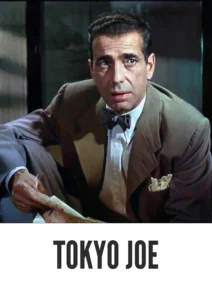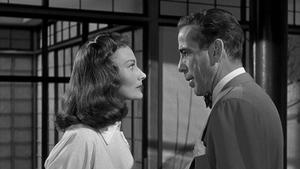Contact: info@alwanfilm.com
Video Sources 0 Views
- Watch trailer
- Tokyo Joe


Synopsis
Table of Contents
ToggleReview: Tokyo Joe 1949 Colorized – A Gripping Tale of Redemption and Intrigue

Introduction
Tokyo Joe, released in 1949, offers a riveting exploration of post-war Japan through the eyes of a former American soldier turned smuggler. Directed by Stuart Heisler, this film noir masterpiece navigates the complexities of love, loyalty, and betrayal against the backdrop of a war-torn nation. In this review, we’ll delve into the compelling narrative of Tokyo Joe and its enduring relevance in the annals of cinema.
Check The Full Colorized Movies List
Check Our Colorized Movies Trailer Channel
Understanding Tokyo Joe 1949 Colorized Director, Cast, and Genre
Directed by Stuart Heisler, Tokyo Joe features Humphrey Bogart in the lead role alongside a talented ensemble cast including Florence Marly and Sessue Hayakawa. The film belongs to the film noir genre, renowned for its atmospheric cinematography, morally ambiguous characters, and dark thematic elements.
Exploring the World of Tokyo Joe 1949 Colorized: Plot and Characters
Tokyo Joe follows the journey of Joe Barrett, a former American pilot who returns to Japan after the war to reclaim his nightclub and reunite with his estranged wife Trina. However, he soon becomes entangled in a web of deceit and betrayal as he confronts his past and grapples with the consequences of his actions. Against the backdrop of post-war Tokyo, Joe must navigate a treacherous landscape fraught with danger and uncertainty.
The Art of Film Colorization
While Tokyo Joe was originally filmed in black and white, its early colorized version adds a new dimension to its atmospheric visuals. The colorization process enhances the film’s evocative cinematography and captures the vibrancy of post-war Japan with striking clarity.
Early Colored Films: A Brief History
The history of early colored films is marked by innovation and experimentation as filmmakers sought to enhance the visual appeal of their movies. From hand-tinted frames to pioneering technicolor processes, the evolution of colorization techniques transformed the cinematic landscape, offering audiences a new way to experience the richness and depth of film.
Tokyo Joe (1949) and Its Early Colored Version
The decision to release Tokyo Joe in a colorized format was made with the intention of immersing audiences in the vibrant atmosphere of post-war Japan and enhancing the film’s visual impact. While some purists may prefer the original black and white version, the early colorized edition of Tokyo Joe adds a new layer of depth to its atmospheric cinematography and captures the cultural nuances of its setting with breathtaking clarity.
The Debate Over Film Colorization
The debate over film colorization continues to divide audiences and industry professionals alike. While some argue that colorization breathes new life into classic films and makes them more accessible to modern audiences, others maintain that it compromises the artistic integrity of the original work. As technology advances and filmmaking techniques evolve, the debate over colorization remains a topic of ongoing discussion within the film community.
Examining Tokyo Joe (1949) as an Early Colored Film
Viewing Tokyo Joe in its early colorized iteration offers audiences a fresh perspective on its evocative visuals and cultural significance. The colorization process enhances the film’s atmospheric cinematography and captures the vibrancy of post-war Japan with stunning clarity. As viewers are transported to the bustling streets of Tokyo, they are immersed in a world of intrigue and danger, where the line between friend and foe is blurred and redemption comes at a steep price.
Influence and Legacy: Tokyo Joe 1949 Colorizeds Impact on Cinema
Tokyo Joe remains a landmark film in the film noir genre, celebrated for its gripping narrative, atmospheric cinematography, and memorable performances. Its exploration of themes such as love, loyalty, and redemption resonates with audiences of all generations, making it a timeless classic that continues to inspire filmmakers and captivate viewers around the world.
Director’s Cinematic Legacy: Beyond Tokyo Joe 1949 Colorized
Stuart Heisler’s directorial legacy extends far beyond Tokyo Joe, encompassing a diverse body of work that includes acclaimed films such as The Glass Key and Smash-Up: The Story of a Woman. As one of the most respected filmmakers of his generation, Heisler was known for his ability to craft compelling narratives that resonated with audiences on a deep and emotional level. Tokyo Joe stands as a testament to his talent and creativity, solidifying his reputation as one of the great auteurs of classic Hollywood cinema.
Themes Explored in Tokyo Joe 1949 Colorized
At its core, Tokyo Joe explores themes of love, loyalty, and redemption against the backdrop of post-war Japan. Through its morally complex characters and evocative visuals, the film offers a nuanced portrayal of the human condition, challenging viewers to confront their own beliefs about right and wrong as they navigate the treacherous waters of love and betrayal.
Reception and Controversy Surrounding Tokyo Joe 1949 Colorized
Upon its release, Tokyo Joe received widespread critical acclaim for its gripping narrative, atmospheric cinematography, and memorable performances. While the decision to release the film in a colorized format sparked debate among purists, its enduring popularity has cemented its status as a timeless classic of the film noir genre.
Where to Watch Tokyo Joe 1949 Colorized Online
For those eager to experience Tokyo Joe for themselves, the film is readily available on popular streaming platforms such as Amazon Prime Video, Google Play Movies, and iTunes. Whether viewed in its original black and white format or its early colorized iteration, Tokyo Joe offers a cinematic experience that is both captivating and visually stunning.
FAQs About Tokyo Joe 1949 Colorized
1. Is Tokyo Joe based on a true story?
No, Tokyo Joe is a fictional film that explores the complexities of post-war Japan through the eyes of its protagonist, Joe Barrett. While the film’s storyline may draw inspiration from real-life events, its characters and plot are works of fiction.
2. Who starred in Tokyo Joe?
Tokyo Joe stars Humphrey Bogart in the lead role of Joe Barrett, a former American pilot who returns to Japan after the war to reclaim his nightclub and reunite with his estranged wife Trina. He is supported by Florence Marly, Sessue Hayakawa, and Alexander Knox in key supporting roles.
3. What is the central message of Tokyo Joe?
At its core, Tokyo Joe explores themes of love, loyalty, and redemption in the aftermath of war. Through its morally complex characters and evocative visuals, the film offers a nuanced portrayal of the human condition, challenging viewers to confront their own beliefs about right and wrong as they navigate the treacherous waters of love and betrayal.
4. Why was Tokyo Joe released in a colorized format?
The decision to release Tokyo Joe in a colorized format was made with the intention of immersing audiences in the vibrant atmosphere of post-war Japan and enhancing the film’s visual impact. While some purists may prefer the original black and white version, the early colorized edition of Tokyo Joe adds a new layer of depth to its atmospheric cinematography and captures the cultural nuances of its setting with breathtaking clarity.
5. What is the legacy of Tokyo Joe?
Tokyo Joe remains a landmark film in the film noir genre, celebrated for its gripping narrative, atmospheric cinematography, and memorable performances. Its exploration of themes such as love, loyalty, and redemption resonates with audiences of all generations, making it a timeless classic that continues to inspire filmmakers and captivate viewers around the world.
6. Are there any sequels or remakes of Tokyo Joe?
No, there have been no official sequels or remakes of Tokyo Joe. However, the film’s enduring popularity has inspired countless reinterpretations and homages in various media. Nonetheless, none have captured the gripping narrative and evocative atmosphere of the original 1949 classic.
7. Where can I watch Tokyo Joe online?
For those eager to experience Tokyo Joe for themselves, the film is readily available on popular streaming platforms such as Amazon Prime Video, Google Play Movies, and iTunes. Whether viewed in its original black and white format or its early colorized iteration, Tokyo Joe offers a cinematic experience that is both captivating and visually stunning.
Conclusion
In conclusion, Tokyo Joe (1949) stands as a gripping tale of love, loyalty, and redemption set against the backdrop of post-war Japan. Whether viewed in its original black and white format or its early colorized iteration, Stuart Heisler’s insightful direction and the stellar performances of the cast offer a cinematic experience that is both captivating and visually stunning. As viewers are drawn into the intricate web of deceit and betrayal, they are treated to a visceral journey that challenges their beliefs about right and wrong and leaves a lasting impact on their understanding of the human condition. Tokyo Joe remains a timeless classic that continues to enthrall and inspire audiences around the world.













